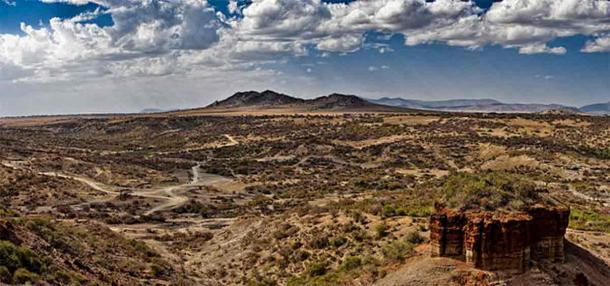Language Developed 8 Times Earlier Than Previously Thought, Says New Book
A landmark new book that has researched evolutionary and linguistic development of prehistoric humans, has found that language might be older almost 8 times over what was previously believed, i.e., 1.6 million years ago, instead of 200,000 years ago! This practice of the most rudimentary forms of language likely began in eastern or southern Africa, which corresponds with an increase in brain size and a slew of other evolutionary developments between 2 and 1.5 million years ago.
- Ancient Human Brains Found Preserved Through Millennia
- Prehistoric Humans Didn’t Grunt Their Ideas - They Used Hand Gestures
Speech and Pre-Frontal Cortex: A Hand in Hand Development!
“Humanity’s development of the ability to speak was without doubt the key which made much of subsequent human physical and cultural evolution possible. That’s why dating the emergence of the earliest forms of language is so important,” said British archaeologist Dr. Steven Mithen, professor of early prehistory at the University of Reading, to The Independent. He is the author of the fascinating new book ‘The Language Puzzle’.
Until recently, experts believed humans began speaking only 200,000 years ago. However, based on a detailed study of all the available archaeological, paleo-anatomical, genetic, neurological and linguistic evidence, Professor Mithen's research suggests rudimentary language’s birth is much older, occurring between two and 1.5 million years ago.
- Brain’s Evolutionary Explosion Linked to Ancient Retrovirus Infection
- Did a Superhuman Genetic Mutation Rewire Human Evolution? (Video)

A model of the face of an adult female Homo erectus, one of the first truly human ancestors of modern man. It is now believed that humanity's earliest rudimentary language likely emerged approximately 1.6 million years ago. (Tim Evanson/CC BY-SA 2.0)
Human brain size notably increased after 2 million BC, especially post-1.5 million BC, leading to the emergence of Broca’s area associated with language. Broca's area is a region of the brain, specifically located in the frontal lobe, associated with language production and comprehension. It plays a crucial role in speech and language processing, particularly in the formation of sentences and the expression of thoughts and ideas.
![Broca's area (shown in red). (Polygon data were generated by Database Center for Life Science(DBCLS)[2]./CC BY-SA 2.1 JP)](https://www.ancient-origins.net/sites/default/files/styles/large/public/brocas.jpg?itok=bz13KtCD)
Broca's area (shown in red). (Polygon data were generated by Database Center for Life Science(DBCLS)[2]./CC BY-SA 2.1 JP)
Broca’s area likely evolved from structures linked to early communication methods. Recent studies suggest Broca’s area development was tied to improvements in working memory, vital for constructing sentences.
Besides brain evolution, advancements in bipedalism around 1.8 million years ago, coupled with changes in skull shape, likely influenced vocal tract development, facilitating speech. Archaeological evidence points to around 1.6 million BC as the approximate start of human speech, reports Financial Times.
Language as A Compensatory Evolutionary Strategy?
Language likely evolved as a compensatory strategy for humans' relative physical weakness compared to other animals. It aided in group coordination, crucial for hunting large animals or repelling rivals. Human hunting began around two million years ago, accelerating significantly by 1.5 million years ago. The emergence of sophisticated stone tool technology around 1.6 million BC, along with inter-generational cultural transmission, strongly suggests the existence of speech.

One of the probable locations where humans initially started to speak is Tanzania's renowned Olduvai Gorge, celebrated for its Stone Age archaeology./CC BY 2.0)
The acquisition of language by Homo sapiens remains a mystery, with iconic words providing just one clue. Genetic mutations altering brain shape facilitated cognitive fluidity, leading to metaphor and abstract thought. Metaphor enhanced communication, driving linguistic and technological advancements: “enhanced communicative power, including the ability to describe and explain complex technological skills and ideas to others”, Mithen suggests.
Tools like spear throwers and bows further spurred linguistic and technological changes, along with developments in the vocal tract and hearing apparatus. The mastery of fire expanded social activities, fostering storytelling and supernatural concepts. Over time, arbitrary words were added to the lexicon, culminating in the diverse languages spoken today. This progression reflects a bootstrap process where brain, language, and material culture propelled humanity into modernity.
Linguistic communication played a pivotal role in human survival across diverse environments. This is evident in the massive acceleration of human colonization around 1.4 million years ago, shortly after the probable birth of language. Language enabled humans to conceive, plan future actions, and pass on knowledge. Professor Mithen's research also indicates continuity between early human languages and modern ones, suggesting that early words likely described objects through various sounds or length.
The research highlights the continuity between early human languages and modern ones. Mithen suggests that certain aspects of the first linguistic development, dating back 1.6 million years, persist in contemporary languages, particularly in words describing objects through their sounds or length.
In addition, he proposes that future research could potentially reconstruct the organization and structure of these early languages. It's important to note that the birth of language around 1.6 million years ago marked the beginning of linguistic development rather than its culmination. Over hundreds of thousands of years, language gradually increased in complexity, ultimately attaining sophistication with the emergence of anatomically modern humans around 150,000 years ago.
As Mithen concludes, “Whether or not we think in words, they certainly augment our thought… the act of labelling items in the world, whether they are sensations, material objects, actions or abstract ideas, makes them salient and concrete.”
Top image: AI image of ancient humans communicating with primitive language and gestures. Source: fotogurmespb/Adobe Stock
By Sahir Pandey
References
Ahuja, A. 2024. The enduring mystery of how humans learned to speak. Available at: https://www.ft.com/content/7581d315-b216-467c-bcd3-d599bd563b8d.
Keys, D. 2024. The 1.6-million-year-old discovery that changes what we know about human evolution. Available at: https://www.independent.co.uk/news/science/archaeology/human-evolution-language-origin-archaeology-b2517744.html.


















Comments
The top photo looks more like a NYSE floor trader than caveman.
Nobody gets paid to tell the truth.